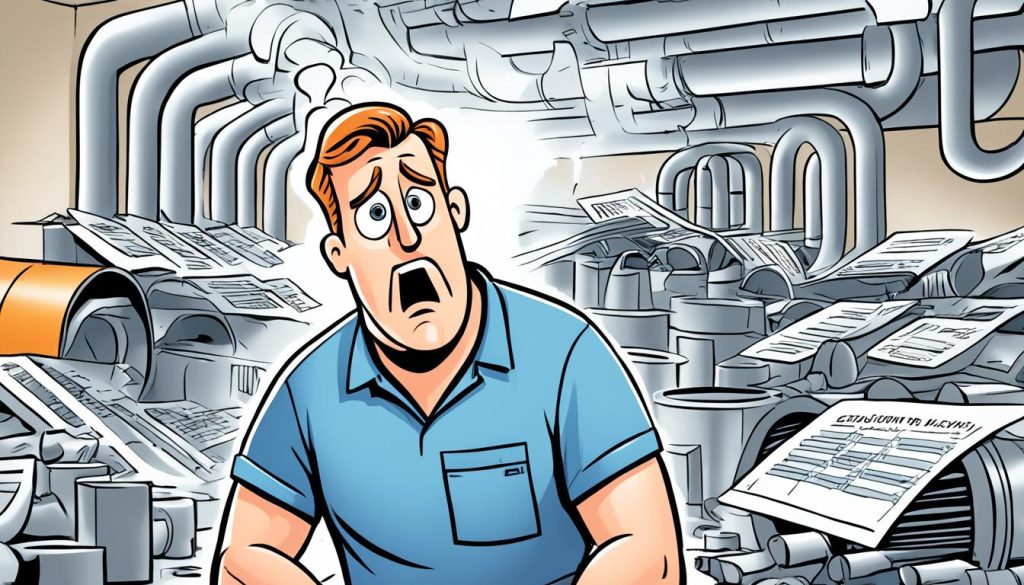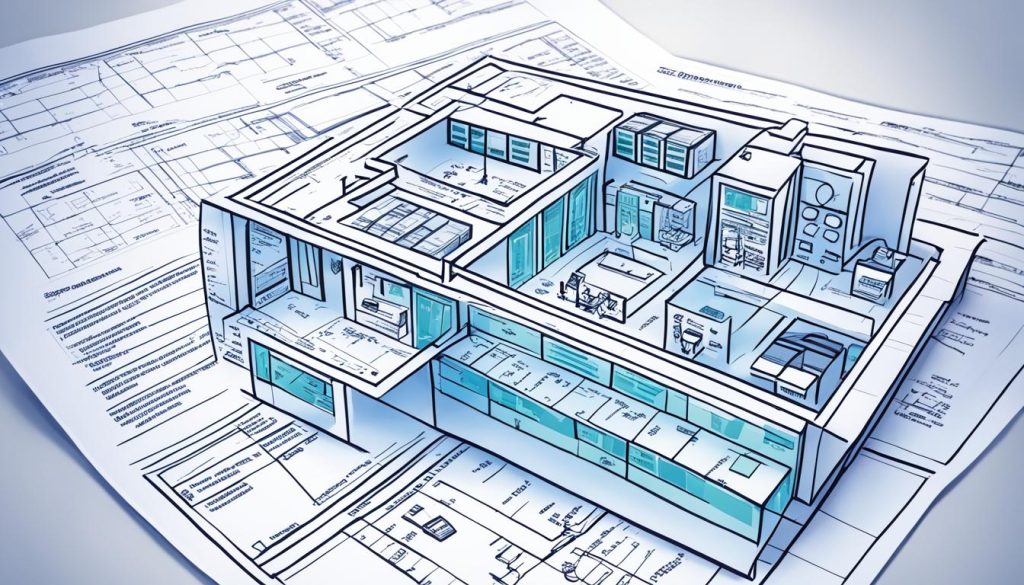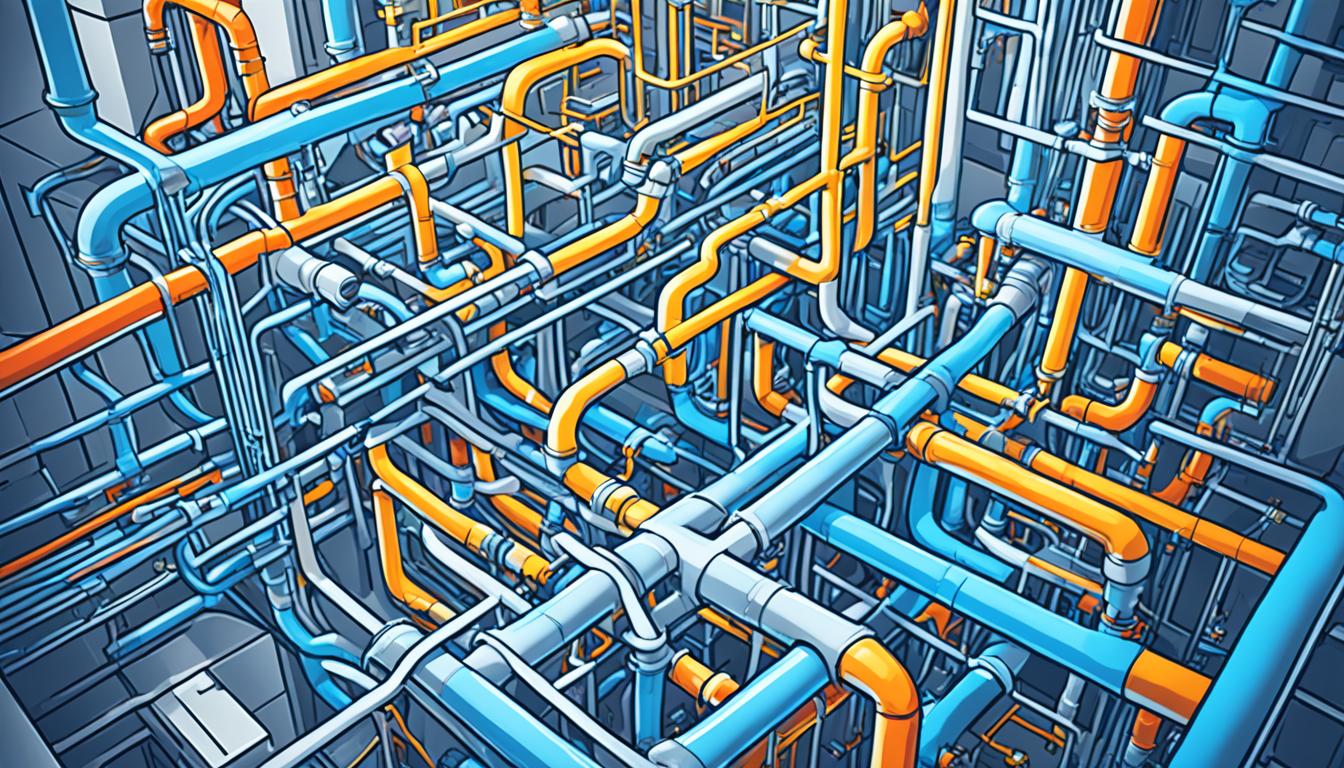Using Manual J calculations helps make sure your HVAC designs follow building codes. This important step in sizing your HVAC system makes sure it works well and keeps people comfortable in homes and businesses.
Manual J is the top method for figuring out HVAC loads, backed by ANSI and needed by many building codes. It looks at things like insulation, how many people will use the space, and the location. This way, you find out exactly what heating and cooling a building needs. It makes sure your HVAC design follows the rules and works its best.
Getting Manual J calculations right is key to designing great HVAC systems. It makes them more efficient, more comfortable, and better overall. By sticking to the best HVAC design practices and using Manual J, you’ll make systems that not only meet the rules but also impress your clients.
Understanding the Importance of Manual J Calculations in HVAC Design
ACCA Manual J is key in designing HVAC systems. It helps make HVAC systems more energy-efficient for homes and businesses. By using Manual J, you can make your HVAC system work better and follow building codes.
What is Manual J and its role in HVAC system design
Manual J is a method created by the Air Conditioning Contractors of America (ACCA). It figures out the heating and cooling needs of a building. It looks at climate, insulation, and how the building is laid out. This method makes sure HVAC equipment is the right size, avoiding problems.
The impact of Manual J on building code compliance
Building codes often need Manual J calculations to check if HVAC systems are sized right. Following these rules helps avoid fines and ensures your system meets standards. Accurate calculations also lead to HVAC systems that use less energy, meeting or beating energy codes.
Benefits of accurate load calculations for residential and commercial HVAC systems
Getting Manual J right has many benefits for HVAC systems:
- Improved comfort levels
- Reduced energy consumption
- Lower operating costs
- Extended equipment lifespan
- Better indoor air quality
| Benefit | Residential Impact | Commercial Impact |
|---|---|---|
| Energy Savings | Up to 30% reduction in utility bills | Significant decrease in operational expenses |
| Comfort | Consistent temperature throughout the home | Improved employee productivity |
| Equipment Lifespan | Extended by 3-5 years | Reduced maintenance and replacement costs |
Using Manual J helps design HVAC systems that meet rules and user needs. This method ensures your HVAC system works well. It also promotes saving energy and making people more comfortable.
Key Components of Manual J Load Calculations
HVAC load calculation is key to designing efficient heating and cooling systems. It looks at several important parts to find the right size for your HVAC system. Let’s dive into these elements that affect heat gain and loss in your building.
The building envelope is a big part of HVAC load calculations. It includes walls, roofs, floors, windows, and doors that keep the inside and outside separate. The insulation’s R-value in these areas greatly changes how heat moves.
Things outside like sunlight, window spots, and the local weather add to heat gain in summer and loss in winter. These are looked at closely to make sure your HVAC system is the right size.
How you use your space and who lives there also matters. The number of people, appliances, and lights affects the building’s heat load.
| Component | Impact on HVAC Load |
|---|---|
| Insulation R-values | Higher R-values reduce heat transfer, lowering HVAC load |
| Window placement | Affects solar heat gain and natural ventilation |
| Occupancy | More people increase heat and humidity levels |
| Appliances | Generate heat, increasing cooling requirements |
By looking at these parts, HVAC experts can figure out the British Thermal Unit (BTU) values needed. This detailed method makes sure your HVAC system is just right. It leads to better comfort and energy use in your home or office.
Steps to Perform a Manual J HVAC Calculation
Getting the right size for an HVAC system is key for both homes and businesses. Manual J calculations are the foundation of this process. They ensure the system works well and saves energy. Here are the steps to do a Manual J HVAC calculation.
Measuring building square footage
First, measure the total area that needs to be cooled or heated. Don’t count unfinished areas like basements or attics. For homes, include all living spaces. For businesses, add offices, lobbies, and areas where people work.
Assessing insulation and external factors
Look at how well the building is insulated and what affects its temperature. Think about the walls, roof, windows, and how the sun hits the building. These things play a big role in how big the HVAC system needs to be.
Determining interior space usage
Think about how each area in the building is used. Kitchens and server rooms need more cooling than bedrooms. This is important for figuring out the right size for the HVAC system.
Identifying British Thermal Unit (BTU) values
Figure out how many BTUs each room needs based on its size, use, and the climate. This is key for sizing the HVAC system right for both homes and businesses.
Calculating total HVAC load
Add up the BTUs for each room to find the total HVAC load. This total helps you pick the right heating and cooling equipment for your project.
| Step | Residential Considerations | Commercial Considerations |
|---|---|---|
| Square Footage | Living areas, bedrooms, kitchen | Offices, lobbies, conference rooms |
| Insulation Assessment | Wall insulation, attic insulation | Building envelope, roof insulation |
| Space Usage | Family activities, cooking frequency | Occupancy levels, equipment heat load |
| BTU Calculation | Room-by-room analysis | Zone-by-zone analysis |
| Total Load | Sum of all residential spaces | Aggregate of all commercial areas |
Ensure HVAC Designs Comply with Building Codes Using Manual J Calculations
Manual J calculations are key to good HVAC design. They help meet building codes and make HVAC systems more efficient. By doing Manual J, you can figure out the heating and cooling needs of a building. This is vital for picking the right equipment size.
Getting the equipment size right is crucial. If it’s too big, it costs more to install and uses more energy. If it’s too small, it can’t keep up during hot or cold spells.
- Manual S: Picks the right equipment based on the load
- Manual D: Designs ducts for better air flow
- Manual T: Makes sure air is spread out well for comfort
Using these ACCA standards in your design means you follow energy codes. These codes are backed by groups like the Department of Energy, RESNET, and EnergyStar.
| Manual J Benefits | Impact on HVAC Design |
|---|---|
| Accurate load calculations | Right equipment size |
| Energy code compliance | Meets legal standards |
| Improved system efficiency | Lower running costs |
| Enhanced occupant comfort | Even temperature control |
Adding Manual J to your HVAC design makes sure you follow the rules. It also leads to systems that are more efficient, comfortable, and save money for your clients.
Integrating Manual J with Manual S, D, and T for Comprehensive HVAC Design
A well-designed HVAC system is more than just Manual J calculations. To get the best performance, you must combine Manual J with other ACCA manuals. Let’s see how these manuals work together for a complete HVAC design.
Overview of Manual S: Equipment Selection
ACCA Manual S is all about picking the right HVAC equipment for your building. It uses Manual J load calculations to help you choose the right size. This way, you avoid systems that are too big or too small, saving energy and making your space more comfortable.
Manual D: Duct Design Principles
ACCA Manual D teaches you how to size and design ducts correctly. It makes sure air flows evenly in your building, saving energy and making everyone more comfortable. By using Manual D, you can fix common issues like uneven temperatures and high bills.
Manual T: Air Distribution Basics
ACCA Manual T focuses on how air moves in your HVAC system. It shows you how to size and place registers, diffusers, and grilles correctly. This manual is key to stopping drafts and ensuring air moves well in every room.
When you use these manuals with Manual J, you get a complete HVAC design. This method ensures your system meets codes and works better, giving you comfort and efficiency. Each manual is important for the best HVAC performance.
Common Challenges and Mistakes in Manual J Calculations
HVAC load calculation errors can cause big problems with system performance and efficiency. It’s important to know these common mistakes for accurate sizing and comfort. Let’s look at some frequent challenges in Manual J calculations.

One big mistake is using wrong data for window U-factors and insulation R-values. This mistake can greatly affect your calculations. Always check these values against the manufacturer’s specs during the building envelope assessment.
Another challenge is when construction documents don’t match the real building. This can lead to wrong calculations. To fix this, do thorough on-site inspections to match your calculations with the actual building.
Not considering all heat sources is another error. Remember to include things like occupancy, lighting, and appliances in your calculations. These sources of heat are key to figuring out the HVAC load.
| Common Mistake | Impact | Prevention |
|---|---|---|
| Incorrect window U-factors | Overestimation of heat loss | Verify manufacturer specifications |
| Inaccurate insulation R-values | Miscalculation of thermal resistance | Conduct on-site inspections |
| Overlooking internal heat gains | Undersizing of cooling systems | Include all heat-generating sources |
| Ignoring local climate conditions | Inappropriate system selection | Use accurate weather data for the region |
Figuring out building tightness is tough but key for load calculations. Wrong air infiltration rates can lead to HVAC systems that are too big or too small. Use blower door tests for better measurements.
Lastly, not considering local climate can cause errors in HVAC load calculations. Each area has its own weather that affects heating and cooling needs. Use specific climate data for your project’s location for accurate Manual J calculations.
Tools and Software for Accurate Manual J Calculations
HVAC design software has changed how professionals do Manual J calculations. These tools bring precision and efficiency to the complex task of load calculations. Let’s look at the options and their benefits.
ACCA-approved Software Options
The Air Conditioning Contractors of America (ACCA) has approved several Manual J calculation tools. These programs are accurate and follow industry standards. Some top choices are:
- Wrightsoft Right-J
- Elite RHVAC
- HVAC-Calc
- EnergyGauge
Each software has its own features but all give reliable results for HVAC load calculations.
Benefits of Digital Tools for Load Calculations
Using HVAC design software for Manual J calculations has many benefits:
- Time-saving: Automated calculations cut down the time spent on manual work.
- Accuracy: Digital tools reduce errors, ensuring precise results.
- Consistency: Software ensures uniform calculations in all projects.
- Flexibility: Easy updates as building specs change.
- Integration: Many tools work well with other ACCA manuals for full HVAC design.
These advantages make ACCA-approved software a key tool for HVAC pros. It helps streamline work and boost accuracy.
| Feature | Manual Calculations | HVAC Design Software |
|---|---|---|
| Calculation Speed | Slow | Fast |
| Error Probability | High | Low |
| Ease of Updates | Difficult | Easy |
| Integration with Other Manuals | Limited | Extensive |
By using these powerful tools, you can make sure your HVAC designs meet building codes. This improves efficiency and accuracy in your projects.
Ensuring Code Compliance Through Proper Documentation and Reporting

Proper documentation is crucial for HVAC code compliance and getting building permits. You must include detailed reports of load calculations, equipment selection, and duct design in your Manual J documentation. Many places require these documents before giving out HVAC permits.
Your documentation must show you meet energy codes and HVAC design standards. This makes the inspection and approval process smoother. Here’s what you should put in your documents:
- Detailed load calculations
- Equipment selection rationale
- Duct design specifications
- Energy code compliance details
- HVAC design standard adherence
Accurate and complete documentation is vital. It not only meets legal needs but also ensures your HVAC system works well. By providing detailed Manual J documentation, you show you’re serious about quality and following HVAC design rules.
When you send in your documents for building permits, keep them well-organized. This makes it simpler for inspectors to check and approve your plans. Think about making a checklist to make sure you have all the needed info before you send it.
Conclusion
Proper Manual J calculations are crucial for HVAC design. They help create systems that meet building codes and work efficiently. By combining Manual J with Manuals S, D, and T, you can design systems that are both comfortable and energy-efficient.
As buildings evolve and the push for energy-efficient HVAC grows, accurate load calculations become more important. These tools help you plan systems that fit any space well. They also make sure your designs follow local rules and keep people comfortable all year.
Good HVAC design is more than just following codes. It’s about making spaces where people can live and work comfortably. By using Manual J and other tools, you can ensure your HVAC systems do just that. As the industry advances, these skills will become even more crucial for creating smart, efficient buildings.





0 Comments